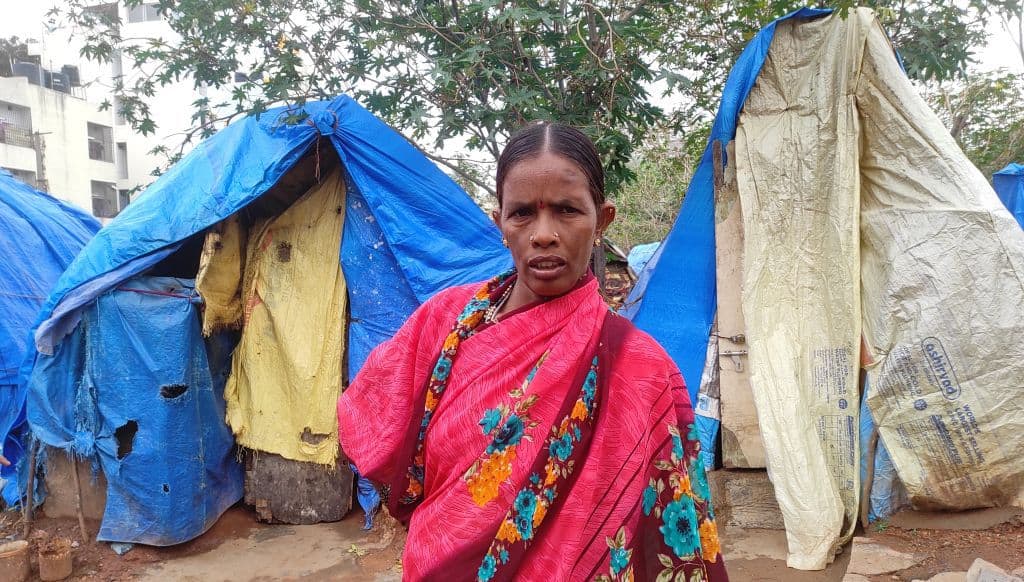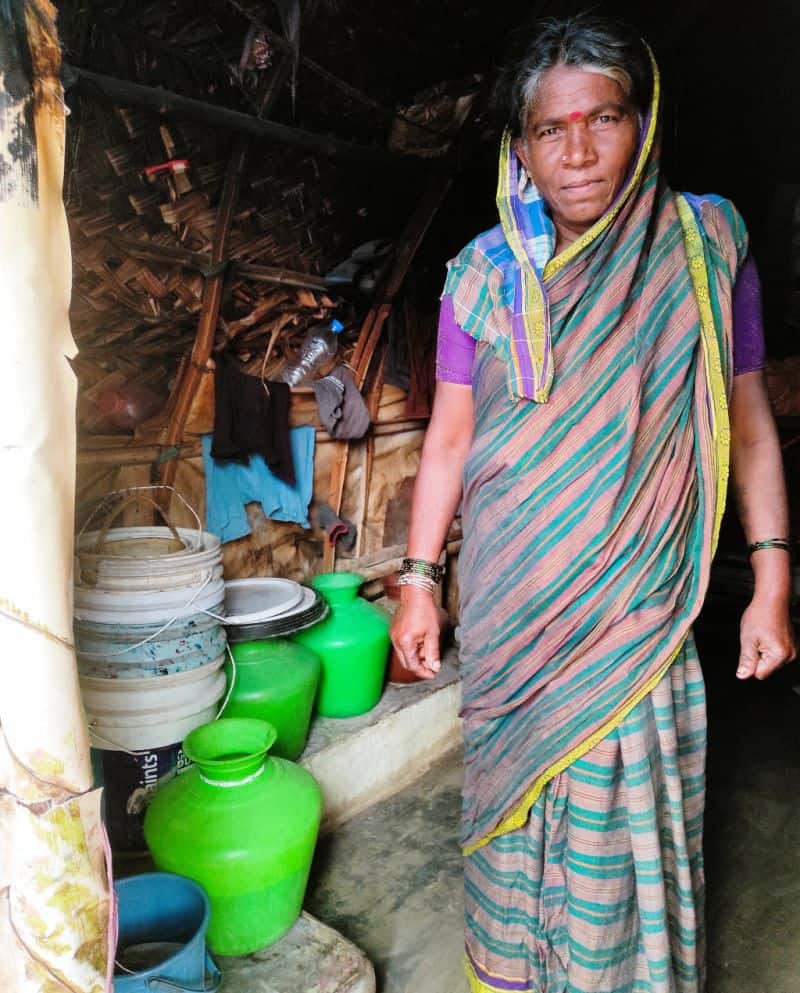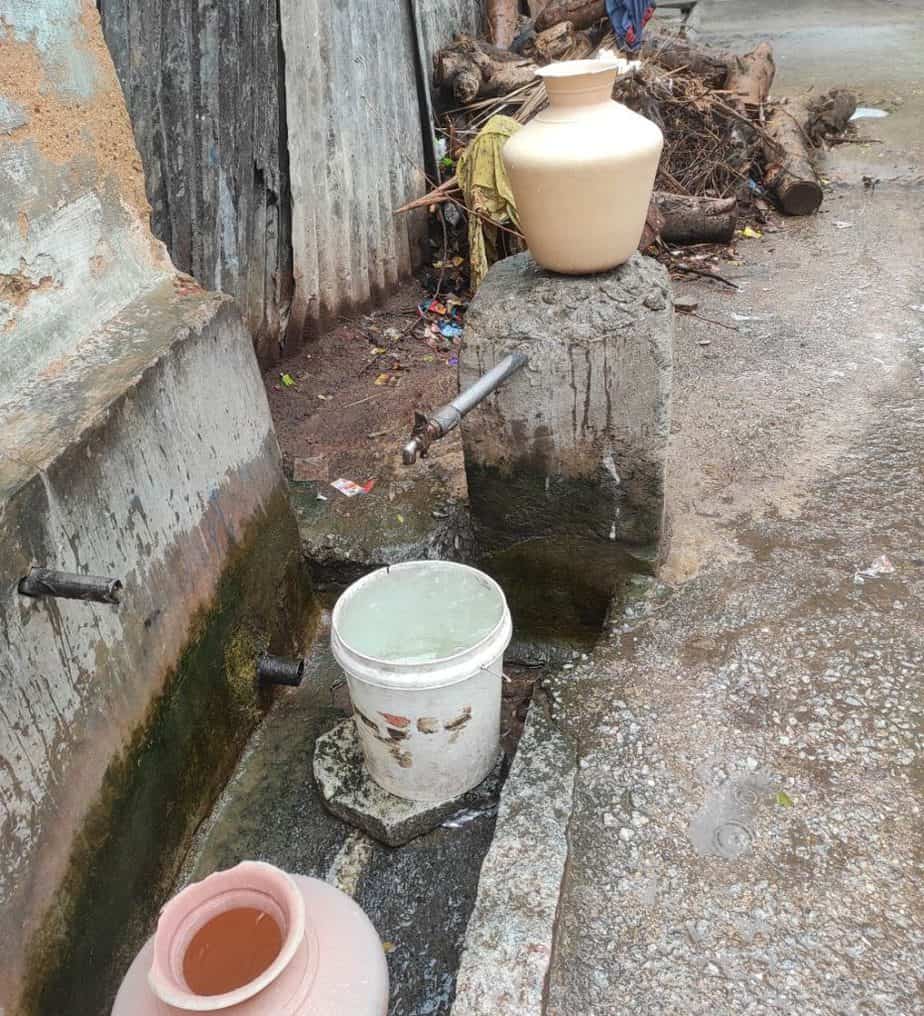Lakshmi, a resident of Chikka Banaswadi in Bangalore, and the 30 other families who live there, have no access to water. Lakshmi buys nine plastic pots of water every day from shops nearby paying Rs 2 per pot.
Even if each pot holds 20 litres, nine pots give Lakshmi, her husband and two children, just 180 litres of water per day for drinking, bathing, washing dishes, etc., whereas the Centre’s Ministry of Housing and Urban Affairs recommends daily water supply of 135 litres per capita in urban areas.

The occupants in this settlement are migrants from North Karnataka, and are mostly daily wage labourers. All the families here live in thatched huts covered by tarpaulin sheets held together with ropes. Lakshmi, who came here six years ago, says sourcing water has always been difficult.
“We buy water from whoever is willing to sell,” says Thayappa, another resident. “Households with 6-8 members may need about 20 pots of water daily, which would cost Rs 40. It’s a big expense. There is a public borewell nearby, but we pay for that too.” Thayappa is unsure of the quality of the water they buy. “I don’t know what kind of water it is but this is the only water we get, so we just use it,” he says.

Rajendra Prabhakar, who heads Maarga, a community organisation of slum residents, says water shortage is worse in undeclared slums like this one in Chikka Banaswadi. “In officially declared (recognised) slums, residents can demand water and other basic amenities from the government,”he says. “They may have a chance of getting Cauvery water. This is not the case in undeclared slums.” A 2018 study had found that only 597 out of over 2000 slums in the city are officially recognised.
“In the absence of Cauvery water supply, a large proportion of slum residents in Bengaluru depend on public borewells,” says Rajendra. “These are borewells built by the government as a temporary arrangement when people demanded water. Slum residents use this water for drinking purpose too without filtering, which is a public health concern. For example, slums in Nagavarapalya, Bangarappa Nagara (near Banashankari), Ragi Gudda slum, all rely on borewell water. In some areas, water from public borewells is even sold. The government is not monitoring its borewells, who all are using it and for what purposes”.
Read more: When families live on three pots of water a day: Lessons from Chennai slums
Water ATMs are popular, but too expensive for many
Rajendra says that other than borewells, a popular option among slum residents is water ATMs that charge Rs 5 for a 20-litre can.
Shalu, who lives in a shack adjoining a compound wall along DJ Halli main road, collects water worth at least Rs 50 per day (10 cans) from the water ATM nearby. The water is stored in several pots and a couple of barrels in her shack. This water is used for all purposes from drinking and cooking to bathing, and is not sufficient for the needs of her 10-member joint family that includes children and elders.
On some days, the water requirement can go up to 15 cans, says Shalu. She says that the family currently earns only around Rs 200 per day from selling shoes along the roadside, and the high water cost is eating into this income.

Babu, the operator at the DJ Halli water ATM says nearly 20 people collect water from there everyday. The water ATM here was built using the local MLA’s grants.
Water ATMs usually draw water from borewells and purify it through reverse osmosis (RO). They became popular around 2014, when legislators started setting them up widely using their Local Area Development grants. The revenue from each ATM is supposed to be used for its continued operations.
Many private companies have also set up water ATMs over the last few years. For example, Dr. Water, a chain of private water ATMs in the city, charges Rs 8 per 20 litres of water.
Though the price of water at ATMs is low compared to that of water cans sold by private companies, this recurring cost is too high for poor families. “Sometimes they say they have no money, so I make adjustments for them,” says Babu at the DJ Halli water ATM. “The demand is higher here when Cauvery water supply is irregular in some lanes”.
Read more: Can water ATMs ease the daily struggle of the poor in Bhubaneswar?
In DJ Halli, a largely low-income area, Cauvery water comes in public taps about two days per week. Residents collect this water in pots and make it last the week.
Water from public taps is also available around Tannery Road nearby. Rahmatunnisa, whose home is in a cluster of dilapidated homes here, says that the nearby public tap serves around eight families. She is happy with the free water supply, but says it is at times erratic. The water flow is low and could stop suddenly at different times of the day.
“In the last couple of months, water supply fully stops after every eight days, and then there may be no water for a day, but we stock it in barrels, so there is no issue,” says Rahmutunnisa, who lives alone. She fills up a barrel and makes the water last for 15-20 days at a time.

Tanker water prices have increased
Rajendra says slum dwellers usually don’t rely on private tanker water, buying it only for family events or so.
In some areas like the slum rehabilitation quarters in Sulikunte though, the residents have no other option. The quarters built outside the city by the Karnataka Slum Development Board to rehabilitate evictees from the erstwhile Ejipura slum, have no water supply yet. Though there are borewells in the premises, no power connection has been given, so water can’t be pumped out.
Amala Fathima, a resident at the Sulikunte quarters, says that since summer, tanker prices here have increased from Rs 550 to Rs 650. For her two-member family, the monthly cost of water now comes to Rs 1,300. A gig worker for a salon company, Amala says her monthly income fluctuates widely, from Rs 3,000 to Rs 20,000, and expenses are difficult to manage in the lean months.
Another resident Shakeela lives with her daughter, and has monthly household income of Rs 6,000 only. For her, the monthly water cost of Rs 1,300 comes to nearly a quarter of the household income.
Clearly, a lot needs to be done to make water accessible and affordable for the poor in Bengaluru.